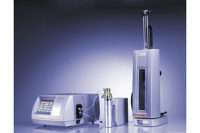The Future is Flexible
By MOLLY V. STRZELECKI
Versatility and flexibility combine with new technology for better labeling equipment
A bottle sits on a shelf, hoping to be picked up by a thirsty consumer.
The one that gets grabbed the most isn’t just the one with a tasty
liquid inside; it’s also the one with an eye-catching label wrapped
around it. This end product is seemingly what will grab dollars and market
share for beverage companies, but in reality, the race starts before that
label even meets the bottle.
Labeling equipment manufacturers are meeting the
demands for better production lines for beverage companies. To keep up with
the fast-paced and ever-changing needs of beverage production, labeling
equipment manufacturers constantly have to be
on their toes with the latest machinery that will keep production running
at the best capacity.
Serving up servos
These days, the latest and greatest in labeling
equipment is tapping into the best technology available.
“Everybody seems to be looking for more
streamlined lines,” says Dan Michaelis, vice president of sales for
Ontario-based Multi-Tech Systems International. “We feel that newer
technology is going to be more electrical than ever before. New servos are
coming out, and the newer electronics are going to be incorporated into the
labeling equipment.” Michaelis explains that two years haven’t
made a big difference in the mechanics of a machine, but electronics from
two years ago are old news, and completely different than electronics
today.
“Photo eyes from two years ago are completely
outdated now,” he says. “The electronics [for labeling
equipment] are growing so much, and we are constantly looking at how to
better tie-in with the rest of the equipment [on the line]. Servos that
couldn’t keep up before are now phenomenal.”
With new control logics and servo-controls for
equipment, says George Albrecht, vice president of sales for Axon
Styrotech, Raleigh, N.C., “you get much more positive cutting
application of the machinery and tying into the rest of the production
line. There is communication throughout the entire line, with other pieces
of machinery and equipment.”
Flexibility counts
Flexibility is a word often bandied about when it
comes to beverage production in general, and
with labeling equipment, in particular, the word crops up as an important
factor in a good piece of machinery. It is nearly as important as the
ever-important V-word: versatility.
“In the past year, it seems that flexibility has
been the most important thing,” says Tom Kauffman, vice president of
sales for P.E. USA – Labelers, Cincinnati. “With new
developments in marketing labeled products, customers have to be forward
thinking in regard to flexibility, label material type, speed, and more,
when selecting a labeling system.”
For a machine to be considered versatile, it must be
set up for fast and easy changeovers. Additionally, a machine’s
versatility speaks to whether or not changeovers require tools, Michaelis
says.
Modular machines are having a big impact on beverage
production for just this reason. The equipment is not only more versatile
in meeting the line’s production needs, but on average, is much
smaller than other equipment, making it easier to handle.
“A small footprint is a necessity to fit into
plants,” explains Nadia Vizza, marketing manager for Pinellas Park,
Fla.-based Polypack. “Configuration changes are happening more often
and it is important to build a system that offers easy changeovers.”
“Flexible and modular labelers allow for the
production of a variety of containers on the same labeler,” notes
Olivier Huss, marketing development manager of labeling for Duluth,
Ga.-based Nordson. “One modular machine can handle magazine-fed,
roll-fed, cold-glue or pressure-sensitive labels, allowing manufacturers to
switch products at low conversion cost. This is particularly appealing to
contract packers.
“If the company wants to change the look of its
product, it doesn’t have to invest in a completely new
machine,” Huss continues. “It just buys a module that allows
them to produce the kind of label they need, whether it’s partial
labels, shrink wrap, etc. They can do it with the same machine.”
Friederike Arndt, of KHS in Bonn, Germany, notes that
the company’s latest introduction, a modular piece of equipment
called the Innoket SE, has been “deliberately kept simple,”
giving ease and versatility. It features a table construction and central
labeling carousel matched to the system requirements specific to the line.
The labeling carousel can be flexibly equipped with a wide variety of
labeling stations, Arndt notes, “whether cold-melt, hot-melt,
adhesive-pressure, or roll-fed labeling stations — they are all
doable. The Innoket SE embodies a labeling concept with modular design,
which has the advantage that all modules can be easily changed if new
labeling requirements should arise within the organization.”
Need for speed
In the performance of
labeling equipment, manufacturers will agree that they look for less
downtime, more throughput and higher speed. Higher speed means more
product, and more product means more bottom line.
Norwalk, Conn.-based PDC International has a line of
continuous-duty shrink tunnels that process heat-shrinkable sleeve labels,
tamper-evident bands and more, all at extremely high speeds.
“From a labeling standpoint, we make one of the
faster, single-headed machines in the industry,” says Gary
Tantimonico, vice president of PDC. “We make a machine that can go up
to 600 containers per minute for a single head for a full-body sleeve
label. For tamper-evident, we make a machine that can produce 1,000 per
minute.” Combined with consistently positive placement, a higher
speed machine can make the entire line of production more efficient.
“The latest and greatest labeling equipment can
enable improvements in filling speeds,” says Martin Wilson, president
of SleeveCo Inc., Dawsonville, Ga. “Recent speed and output
enhancements in machinery have been driven by high-speed filling and other
production line demands. A machine’s capability of handling
multiple-sized containers creates cost efficiencies. These all factor into
lowering the company’s overall label application cost.”
Eco-labeling
Al Gore isn’t the only one concerned with the
environment. These days, beverage manufacturers also are looking to offer
more environmentally friendly products from start to finish, including
labeling.
“A lot of the [large beverage] companies are
trying to show they’re environmentally friendly,”
Nordson’s Huss notes, adding that this has resulted in in the use of
lighter and thinner bottles. But because of new, environmentally friendly
containers, “labeling equipment therefore has to handle more fragile
label stock and containers at greater speeds without compromising on
efficiency, and without damaging the end product and aesthetics,” he
says.
Thinner and more environmentally friendly label
materials can present a challenge for labeling equipment manufacturers,
notes PDC’s Tantimonico. The thickness of the sleeve label is very
important to the labeling process, and if the label is too thin, it can
become difficult to apply.
Not only are earth-conscious products introducing a
challenge for labeling equipment, so are those companies whose products are
packaged in unconventional bottles. The trend toward the funky means
labeling equipment must be ready to accommodate.
“The shapes of the bottles have become more of a
challenge for manufacturers,” Tantimonico says, “because
it’s not your typical 16-ounce glass or plastic bottle.”
“Highly shaped containers, necessitating a wide
variety of label substrates, have combined with specialty inks to increase
performance demands on shrink application machinery,” says
SleeveCo’s Wilson. “These trends will continue to accelerate
demands for equipment improvements.”
Additionally working toward
environmentally friendly equipment and products, Alan Shipman, vice
president of sales for ID Technology Corporation, Ft. Worth, Texas, says
that many print engines in the printer applicators are conforming to
European Rohs compliance specification that removes lead.
The future in a bottle
For labeling equipment manufacturers, the future is
bright with continuing innovation, coming in the form of faster, more
versatile equipment, and more high-tech equipment.
“As [companies] grow and as their
requirements pick up, the speeds increase proportionally,” says
Axon’s Albrecht. “The future of the industry, per se, is from a
standpoint of sophistication of the mechanics of it, as well as the higher
speeds that are being dictated in the marketplace.”
“The biggest changes in labeling is focusing on
the electronics of the machine,” Michaelis says.
As labeling equipment continues to improve, it will
also play a hand in more integrated production.
“I see more integration,” Huss says.
“Right now, you make the container, then later, put the label on it.
There are some technologies that are very much in use in Southeast Asia
where you put the label on when you make the container itself. It’s
two-in-one, and that saves a lot of money.”
“In the beverage industry, labeling is here to
stay,” P.E. USA – Labelers’ Kauffman says.
“Customers today want quality performance and a high level of
efficiency.” Thus, he notes, the future is wide open for labeling,
and the beverage industry will continue to push labeling equipment
manufacturers to build accuracy, user-friendly, and efficiency into their
labeling systems.
Tea in a box
Arizona announced its new “Fridge Box.”
The brand from Ferolito Vultaggio & Sons, Lake Success, N.Y., launched
its Lemon Tea, Green Tea, Diet Green Tea, Raspberry Tea and Sweet Tea in
the new package. The Fridge Box is a 12-pack dispenser carton that holds 12
11.5-ounce cans. Arizona’s signature graphics and colors will be
carried through the Fridge Boxes. The package is available nationally.
Rugby water
In preparation for the Rugby World Cup, Sidel created
a 0.75-liter PET bottle shaped like a rugby ball. The bottle was designed
with the same oval shape, grainy texture and stiches as a rugby ball and
rests on what looks like a kicking tee. It will hold Alet spring water from
Eaux Minerals d’Alet Co., which is promoting the product as the
“only water packaged in a ball.” The package will be available
in France where the Rugby World Cup will be held Sept. 7 to Oct. 20.
New in plastic
Arkansas’s Mountain Valley Spring Water Co.
redesigned its plastic bottle line. The new bottle shape, designed by
Flowdesign, Detroit, incorporates the company’s signature green
tinted package color and its “Since 1871” tagline, which is
located below a wavy embossed mountain scene. The label features a clear
wrap and echoes the brand’s glass bottle line. The bottle’s
label also features the Mountain Valley red oval icon on the front panel.
Wrapped up
Miller’s caffeinated
alcohol beverage, Sparks, released a new wrapped four-pack. The multipack
features a brand wrap and handle on Sparks, Sparks Plus and Sparks Light.
In addition, the package features two UPC codes, one on each can for
individual sale as well as one for sale as a four-pack. The package is
intended to be easily chilled. It launched this summer in Florida and Ohio,
but Sparks plans to release the package nationally in the coming months,
the company says.
Redesigned LABELS
Heaven Hill Distilleries Inc., Bardstown, Ky., redesigned the labels for
the entire line of Whaler’s Hawaiian-style rums. The flavored line,
including Vanille, “Killer” Coconut, Pineapple Paradise and Big
Island Banana, all feature high-impact graphics. The colorful labels
communicate the names and flavors with bold graphics. In contrast, the
classic Spiced, Original Dark, Great White and Rare Reserve Dark rums are
packaged in a more traditional style featuring the ships of the
brand’s seafaring namesakes.
Heritage made over
New York’s Genesee Beer and Genny Light made
over its packaging as part of a renewed focus on Genesee Brewing’s
core brands. The new packaging designs pay tribute to Genesee’s past
while updating the graphics. Genny Light also received the “classic
heritage” make over to bring it in line with the repackaging of
Genesee Cream Ale that the company did in 2005. The new graphics also are
supported on the Web site, geneseebrewing.com.
Award-winning design
Metromint announced its bottles were recognized in the
2007 Communication Arts Design Annual contest. The graphic design
competition chose the bottles of mintwater as a finalist. The slender PET
bottle features a metallic label that was designed by Metromint founder Rio
Miura. Through in-house agency, Metromint Creative, Miura oversees the
packaging, new product development as well as advertising and marketing of
the brands. Metromint will be featured in Communication Arts’
November Design Annual.



